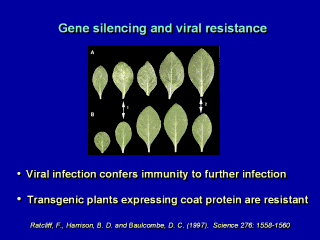| front |1 |2 |3 |4 |5 |6 |7 |8 |9 |10 |11 |12 |13 |14 |15 |16 |17 |18 |19 |20 |21 |22 |23 |24 |25 |26 |27 |28 |29 |30 |31 |32 |33 |review |
 |
Over the past few years, it has become
increasingly evident that there is a connection between the phenomenon of
post-transcriptional gene silencing and the acquisition of viral immunity by
plants. It has long been known that plants can recover from viral infection
and become immune to further infection, as shown in the illustration taken
from a recent publication from David Baulcombe’s lab. Resistance can be
conferred on a plant by a coat protein transgene -- this observation was
made quite some time ago by Roger Beachy and his colleagues, as well as
other groups -- but the mechanism has remained elusive. Dougherty’s lab, for example, showed that: 1. Potato virus X resistance could be conferred by expression of a coat gene whose transcript couldn’t be translated, as well as one that could be translated. This implies that it is the RNA and not the protein that is responsible for virus resistance. 2. The most resistant lines had methylated transgenes that were transcribed at high levels, but had a low steady-state transcript level. This is much the same as is observed in post-transcriptional gene silencing or PTGS. |